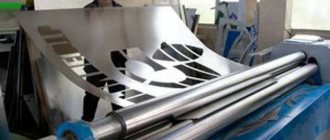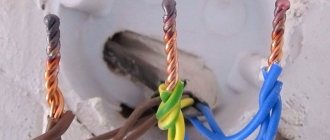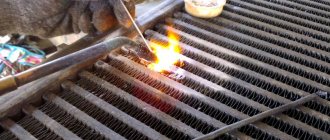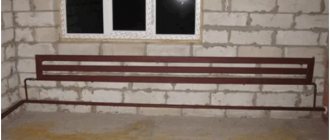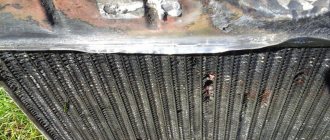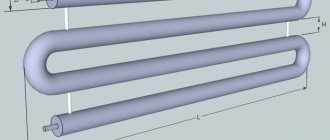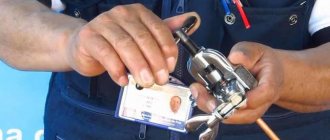Often when installing air conditioners or installing plumbing, it is necessary to roll copper pipes. This is a deformation of the tubes that is carried out for a specific purpose. Any direction can be created.
This activity is carried out in production using a special tool called rollers. And if there is such a need, then you can carry out flaring at home yourself. But in this case, everything must be done carefully in order to bend the tube, but not to violate its integrity, otherwise deformation will occur or a crack will appear.
Rolling of copper pipes: a, b, c - rolling defects (chips, cracks, uneven edges).
The essence of the process
Flaring of copper tubes is the process of deforming products of various types, which can be used to create various mechanisms. A similar technology is used when securing parts in boilers, condensers or other heat exchangers. Among the features of the work carried out, we note the following points:
- The thickness of the walls can be very different. Due to this, the outer or inner diameter changes.
- Copper tubes, which are made from metal with varying degrees of processing, are subjected to flaring.
Types of flaring
As a rule, the diameter changes due to stretching of the product. Using modern equipment, you can obtain a high-quality surface that is ideal for creating hermetic connections.
Execution Features
Flaring of copper tubes may be necessary if:
- the cut end of the tube must be given the required configuration;
- the end of the product must be prepared for its connection using a coupling (in this case, using flaring, the geometric parameters of the tube are adjusted, such as the internal diameter, bending angle, etc.);
- it is necessary to prepare the ends of the copper tubes for their connection by soldering.
Pipes are cut to length using a special tool - a pipe cutter for copper or aluminum pipes
To qualitatively flare a copper tube using special tools and devices, you must perform the following steps.
- The end of the tube whose connection needs to be made is carefully cleaned.
- A special coupling is put on the stripped end.
- Using a special tool or device, the end of the tube is flared until its expansion angle is 45°.
- After the procedure is completed, the end of the product is removed from the device. You can then immediately begin making the connection.
Reamer - devices for stripping the ends of copper tubes
If copper is needed in order to connect it by soldering, then the sequence of actions for carrying out such a procedure will look like this.
- The surface of the end of the tube that needs to be flared is carefully cleaned (for this it is best to use a special brush).
- Using a special device, the end of the copper tube is expanded to such an extent that the end of another tube can be inserted into it and at the same time maintaining a gap of 0.124 mm between the connected elements. Naturally, for this you need to use a measuring tool.
- The flux necessary to ensure the formation of a reliable and tight connection is applied in an even layer to the inner surface of the pipe section that has already been flared.
- The end of the second connection element is inserted into the flared part to a depth equal to the diameter of the pipe.
- Using a gas torch, electric soldering iron or blowtorch, the future joint is heated until the solder begins to melt.
- Melted solder fills all the gaps between the edges of the copper pipes being connected, resulting in a reliable and tight connection.
When might flaring be necessary?
Today, rolling of copper tubes is carried out extremely often. This technology is used in the following cases:
- The shape of the pipe needs to be changed. An example is obtaining an oval cross-sectional shape.
- Most often, flaring is carried out to change the outer and inner diameters. When connecting copper pipes, it is necessary to ensure perfect tightness, which is achieved by adjusting the surfaces to each other.
- Copper tubes of the required shape are not available on sale.
- It is necessary to change the size and shape of the tubes to suit specific conditions.
Flaring tool
Flaring is also performed in the manufacture of jewelry and various mechanisms. Various special tools can be used for work, for example, a cone flaring machine.
Technology and features of the flaring process
The joining of pipeline parts is the most critical moment during installation. The main feature of the process is to give the end of the part a size corresponding to the outer size of the pipe.
If the mating is performed using fittings, flaring increases the contact surface of the two parts, and the natural plasticity of the material ensures tight contact without gaps. In addition, the resulting chamfer at an angle of 45 degrees increases the contact surface.
When connecting copper parts by soldering, the end of the pipe is distributed. In this case, the internal diameter of the processed end should be 0.12-0.2 millimeters larger than the outer size of the tube.
This gap ensures that a layer of solder is applied to its surface. After this, the thin end is inserted into the hole, and the joint is heated with a blowtorch, gas torch or any other available method.
Stages of pipe flaring
It is possible to obtain a product of the required size and shape by using a technology that has long been known. The manipulation is carried out in three stages:
- The required gap is selected between the part and the copper tube sheet.
- Both elements are deformed when using a special tool.
- The pressure exerted is released.
It is worth considering that, regardless of the type of technology used, after flaring the metal becomes softer as it stretches.
Ways to increase pipe diameter
Some materials are characterized by high ductility. That is why you can try stretching a copper blank onto a special conical template. This method is used extremely rarely, since it is difficult to obtain a high-quality part. There is a possibility of ruptures occurring in places where the maximum load is placed.
You can stretch the metal with an expander. The flared pipe in this case is characterized by greater quality. This device comes with interchangeable nozzles that can be used to adjust the diameter.
You can carry out the work in question using a cone. The process involves pressing a cone into the surface of a fixed workpiece in a vice, after which the product is removed. The result obtained is much worse than when using an expander, but the technology is used extremely often.
What tools are used for rolling?
Regardless of the material of the workpiece, it is important to use only high-quality and proven tools; this will help to avoid mistakes and get a high-quality option. In most stores there are dozens of different hand-held instruments that will help you carry out the correct operation.
But in addition to manual devices, there are also electric ones. It is important to understand here that the cost of such equipment is many times higher, but a person will get a better result.
Types of flaring machines
The flaring process is greatly simplified when using special devices. They can be manual or electric, used to work with the pipeline of a heating system or water supply, pipes of other systems, for example, air conditioning. There are also universal versions on sale. The most widespread are:
- Sample. A similar tool is used for working with copper or other soft alloys. Among the features include low cost and ease of use. However, during work, significant defects may appear on the surface.
- A mechanical tube flarer consists of a combination of a carbide roller that can be rolled along the edge to produce the required shape. When using it, you can make a workpiece with a smooth and symmetrical surface. The process is automated and allows you to obtain a high-quality surface. The applied force is increased by threaded and other drives.
- The electrically driven version is equipped with a whole set of replaceable attachments. It is purchased when it is necessary to speed up the production process. The only drawback is the high cost of such a device. It is recommended to purchase the device in cases where flaring is carried out with great frequency.
- Expander. This type is extremely common, as it allows you to deform the surface in just one movement. The simple design means that it is impossible to control the wall thickness. The expander is often used at home, as the device is inexpensive and easy to use.
Electric flaring machine
The mechanism is selected depending on the tasks assigned. For example, when mass producing certain parts, it is best to purchase a flaring machine with an electric drive.
Top best pickers
REMS Hurricane N
A classic manual version that has a simple design and is efficient. The product copes with pipes with a diameter of 10-22 mm, which is a good indicator. The outer part is made of reliable metal. There are comfortable handles for easy grip. The kit includes a universal drill, as well as pliers and lubricant, which allows you to perform operations more efficiently. Can work with both hard and soft pipes, making the product versatile.
The average cost is 52,000 rubles.
REMS Hurricane N
Advantages:
- Manufacturing;
- Life time;
- Quality assurance;
- Universal application;
- Equipment.
Flaws:
- Not detected.
Rothenberger STANDARD
One of the best options, which is suitable for manual production of bends and neck extraction. The tool is capable of working with various types of pipes, including products made of solid copper and a maximum wall thickness of 2.5 mm. Thanks to the small size of the device, the user will be able to carry out operations even in tight spaces, which is an additional advantage. The kit contains all the necessary elements to facilitate the work. The case is made of reliable material that does not deteriorate from frequent use.
The average cost is 44,000 rubles.
Rothenberger STANDARD
Advantages:
- High quality manufacturing;
- Equipment;
- Easy to use;
- Maximum diameter – 54 mm;
- Versatility.
Flaws:
- Not found.
Electric manual pipe beader REMS Hurricane
A convenient model that is simple and reliable. The product is made of durable material and has an electric drive, which allows you to work quickly and efficiently. No maintenance is required and the tool is durable and can handle a variety of pipe types.
The power is 500 W, which is a good result. There is an electronic switch. The product is supplied in a durable case, which is made of sheet steel, which guarantees reliability for the entire period of use. In addition, the kit includes a drilling head.
The only drawback is that the product runs on mains power and not on battery power. Therefore, a person will have to connect the product to a 220 V outlet. The tool complies with safety regulations and is also protected from accidents.
The average cost is 100,000 rubles.
Electric manual pipe beader REMS Hurricane
Advantages:
- Works with various types of pipes;
- Professional assembly;
- Simple operation;
- Convenient design;
- Electronic switch;
- Sold in a durable sheet steel case;
- Full compliance with safety regulations.
Flaws:
- Not found.
Eccentric flaring machine
The common eccentric tube flaring machine is used to produce quality parts. Among the features of this version, we note:
- Pressure is transmitted when force is applied through a mechanical element. The tip is made of high hardness metal.
- The delivery set includes many different tips, changing which you can get a surface of different shapes.
- The cost of such a mechanism is relatively low. A wide variety of metals can be used in manufacturing, for example, those with high corrosion resistance.
To increase the transmitted force, a long handle is used. It is fixed in a special holder.
Rating of popular hydraulic pipe expanders
DSZH CT-300AL
A compact model that guarantees reliability and ease of use. The products are designed for coupling-free connection of various pipes, including brass and titanium. The advantages of this specimen include light weight, compactness and easy use. Sold in a special case that protects the product from moisture and also makes storage more convenient. The kit contains everything you need to carry out various types of work.
The cost is specified when ordering.
DSZH CT-300AL
Advantages:
- Suitable for aluminum pipes;
- Strength;
- High quality manufacturing;
- Convenient use;
- Efficiency;
- Strength indicators.
Flaws:
- Not found.
FavorCool CT-300M
A good hydraulic option that will save time and effort. The product impresses with its reliability and long service life. Replaceable heads are made of hardened steel, which guarantees reliability over long-term use. Sold in a durable plastic case, it protects the product from shock and high humidity. The processed diameters are 10-28 mm, which is a good indicator.
The average cost is 14,300 rubles.
FavorCool CT-300M
Advantages:
- Attractive appearance;
- High-quality assembly;
- Convenient use;
- Value for money;
- Sold in a durable case;
- Efficiency.
Flaws:
- Not found.
How to choose a flaring tool?
In order to achieve high quality when flaring, you should correctly select the most suitable tool. When using the simplest devices, negative consequences can occur:
- Serious ruptures occur in the walls of copper tubes, which significantly reduce the strength and service life.
- Small cracks can cause the walls to wrinkle.
- It is difficult to achieve uniform thickness. Even a slight deviation leads to a decrease in the strength of the formed joint.
Eccentric flaring machine VALUE
You can select a tool for flaring copper tubes by considering the following information:
- Flaring depth.
- Internal diameter of the product.
- Certain characteristics of the material: hardness and degree of ductility.
- Outside diameter.
- Wall thickness. This parameter determines how difficult it is to process the workpiece.
- The distance by which the product can protrude beyond the boundaries of the locking mechanism.
- Distance between centers of internal holes.
- Presence and characteristics of connecting seams. Some blanks are obtained by welding the ends. The resulting weld may react differently to plastic deformation.
- The need to form grooves on the surface. Flaring can also create the required grooves in the copper tubing.
Most of the devices used are characterized by versatility. All mechanisms may also differ from each other.
Tools designed to carry out the work in question allow:
- Eliminate the possibility of severe cuts. This is achieved by gradually applying pressure, which is distributed evenly.
- Achieve uniform wall thickness. Moreover, a similar result can be achieved even if the workpiece initially had uneven walls.
- The hole inside the product becomes smooth and even.
Electrically driven devices are characterized by greater productivity. They are widely used today and are indispensable when it is necessary to deform a product with large wall thickness.
How to make a tool?
A homemade tool can be made for long-term use. The design is quite simple; it is represented by a frame made of two corners of similar geometry. When assembling the mechanism the following is used:
- Bulgarian.
- Two bolts with a thread of at least 8M.
- A corner 100 mm long can be used as the main material. It is best to choose a stainless steel version.
- Mandrels.
Grinding and drilling machine.
The corners are fastened together with bolts. To do this, appropriate holes are made using a drilling machine. Holes are drilled at the base of the chamfer.
Homemade flaring machine
You should work with such a mechanism in the same way as with many others that can be purchased in specialized stores.
How to flare a copper tube?
Due to the high ductility of copper, processing copper tubes made from this alloy is quite simple. Do-it-yourself flaring of copper tubes is carried out as follows:
- The workpiece is clamped in the holder so that it extends beyond the edges by 5-6 mm.
- Instead of a cone, a special nozzle is installed that fits the diameter of the workpiece.
- The fitting is put on, attention is paid to the direction of the thread.
- The die must be made of a material whose hardness is much greater than the hardness of the workpiece. It is pressed in, causing the edge of the end to deform.
- Instead of a stamp, a cone is installed. It is pressed in gradually. Only with uniform exposure can the required quality of the resulting product be ensured.
- After processing, the workpiece is inspected. If minor defects appear, they can be cleaned out.
Some workpieces are less susceptible to processing using the method in question. An example is brittle alloys, in the structure of which cracks and other defects may appear during deformation.

